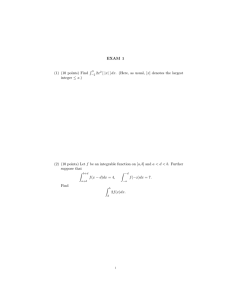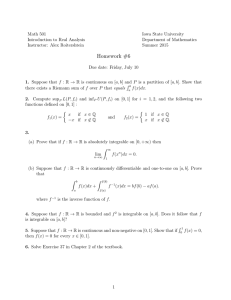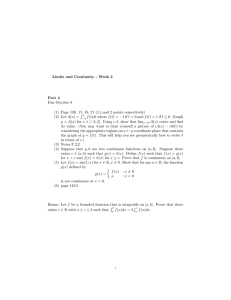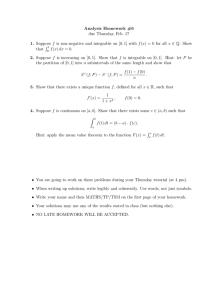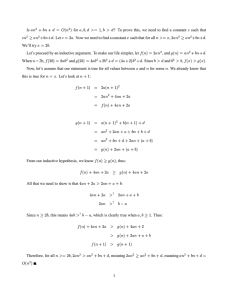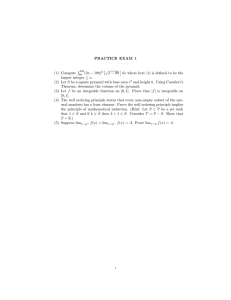Document 13555245
advertisement
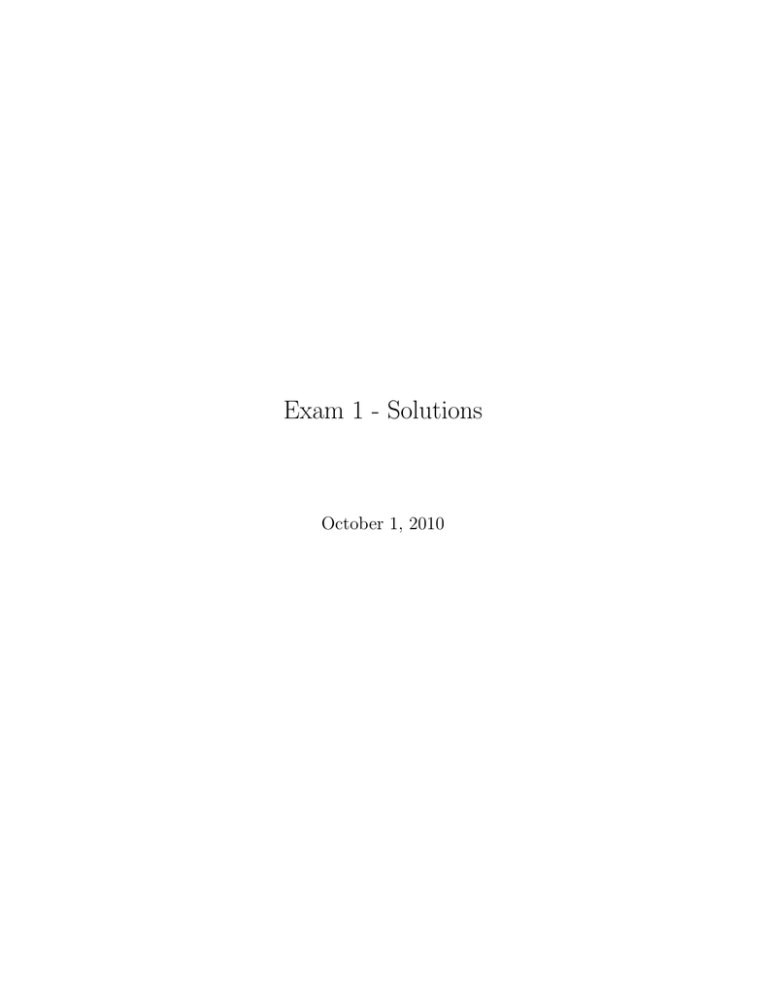
Exam 1 - Solutions
October 1, 2010
Problem 1: Find
integer ≤ x.)
�3
−2
2x2 [ |x| ] dx. (Here, as usual, [x] denotes the largest
Solution Note that
⎧ 2
2x for − 2 < x ≤ −1
⎪
⎪
⎨
0 for − 1 < x < 1
2x2 �|x|� =
2
2x
for 1 ≤ x < 2
⎪
⎪
⎩
2
4x for 2 ≤ x < 3
⎫
⎪
⎪
⎬
.
⎪
⎪
⎭
Hence,
�
�
−1
3
2
2x
�|x|�dx =
−2
�
2
2x dx +
2
2
�
2x dx +
−2
1
3
4x2 dx
2
2
��−1 2
��2 4
��3
= x
3 � +
x
3 �
+
x
3 �
3 −2 3 1 3 2
2 16 16 2 108 32
104
− +
−
=− +
+
=
.
3
3
3
3
3
3
3
Problem 2: Let f be an integrable function on [a, b] and a < d < b. Further
suppose that
�
−d
� b+d
f (x − d)dx = 4,
f (−x)dx = 7.
−a
a+d
Find
�
b
2f (x)dx.
d
Solution Properties of the integral imply
�
b
�
d
f (x) = −7.
f (x)dx = 4,
a
a
�b
�d
�b
�b
As 4 = a f (x)dx = a f (x)dx + d f (x)dx = −7 + d f (x)dx, we see
�b
�b
that d f (x)dx = 11. Again, using properties of the integral, d 2f (x)dx =
�b
2 d f (x)dx = 22.
1
Problem 3: Suppose A, B are inductive sets. Prove A∩B is an inductive set.
Give an example of inductive sets A, B such that A − B is not an inductive
set.
Solution If A and B are inductive sets, then 1 ∈ A, B; thus, 1 ∈ A ∩ B.
Moreover, suppose x ∈ A ∩ B. Then x ∈ A and x ∈ B; hence, x + 1 ∈ A and
x + 1 ∈ B because A and B are inductive sets. But, then x + 1 ∈ A ∩ B.
Therefore, A ∩ B is an inductive set.
Let A = B = R. Then A and B are inductive sets because 1 ∈ R and
because x ∈ R implies x + 1 ∈ R by closure of addition for the real numbers.
However, A − B = ∅ is not an inductive set since 1 ∈
/ ∅.
Problem 4: Let f be a bounded, integrable function on [0, 1]. Suppose
there exists C ∈ R such that f (x) ≥ C > 0 for all x ∈ [0, 1]. Prove that
g(x) = 1/f (x) is integrable on [0, 1].
Solution Let � > 0 and observe that as f is integrable and f ≥ C, there
exist
such that C/2 ≤ s(x) ≤ f (x) ≤ t(x) and
� 1 step functions s(x), t(x)
2
(t(x) − s(x))dx < � · C /4. Let s1 (x) = 1/t(x), t1 (x) = 1/s(x). Then,
0
0 < s1 (x) ≤ g(x) ≤ t1 (x) (we proved that in class on the first day). Moreover,
� 1
� 1
� 1
1
1
t(x) − s(x)
−
(t1 (x) − s1 (x))dx =
dx =
dx.
t(x)
s(x)t(x)
0
0 s(x)
0
By choice, we have that s(x), t(x) ≥ C/2. Thus, s(x)t(x) ≥ C 2 /4 and
1/(s(x)t(x)) ≤ 4/C 2 . It follows that
� 1
� 1
2
t1 (x) − s1 (x)dx ≤ 4/C
(t(x) − s(x))dx < 4/C 2 � · C 2 /4 = �.
0
0
Here the first inequality comes from the comparison principle for integrals of
step functions and the second follows by hypothesis. Thus, by the Riemann
condition, g = 1/f is integrable.
Problem 5: Suppose f is defined for all x ∈ (−1, 1) and that limx→0 f (x) =
A. Show there exists a constant c < 1 such that f (x) is bounded for all
x ∈ (−c, c).
2
Solution First, denote f (0) = B. Let M = max{|B|, |A| + 1}. Since
limx→0 f (x) = A, there exists δ > 0 such that |f (x) − A| < 1 if 0 < |x| < δ.
Thus, for all 0 < |x| < δ,
|f (x)| = |f (x) − A + A| ≤ |f (x) − A| + |A| < 1 + |A|.
Now, set c = δ. Then, for all x ∈ (−c, c), |f (x)| ≤ M .
3
MIT OpenCourseWare
http://ocw.mit.edu
18.014 Calculus with Theory
Fall 2010
For information about citing these materials or our Terms of Use, visit: http://ocw.mit.edu/terms.
